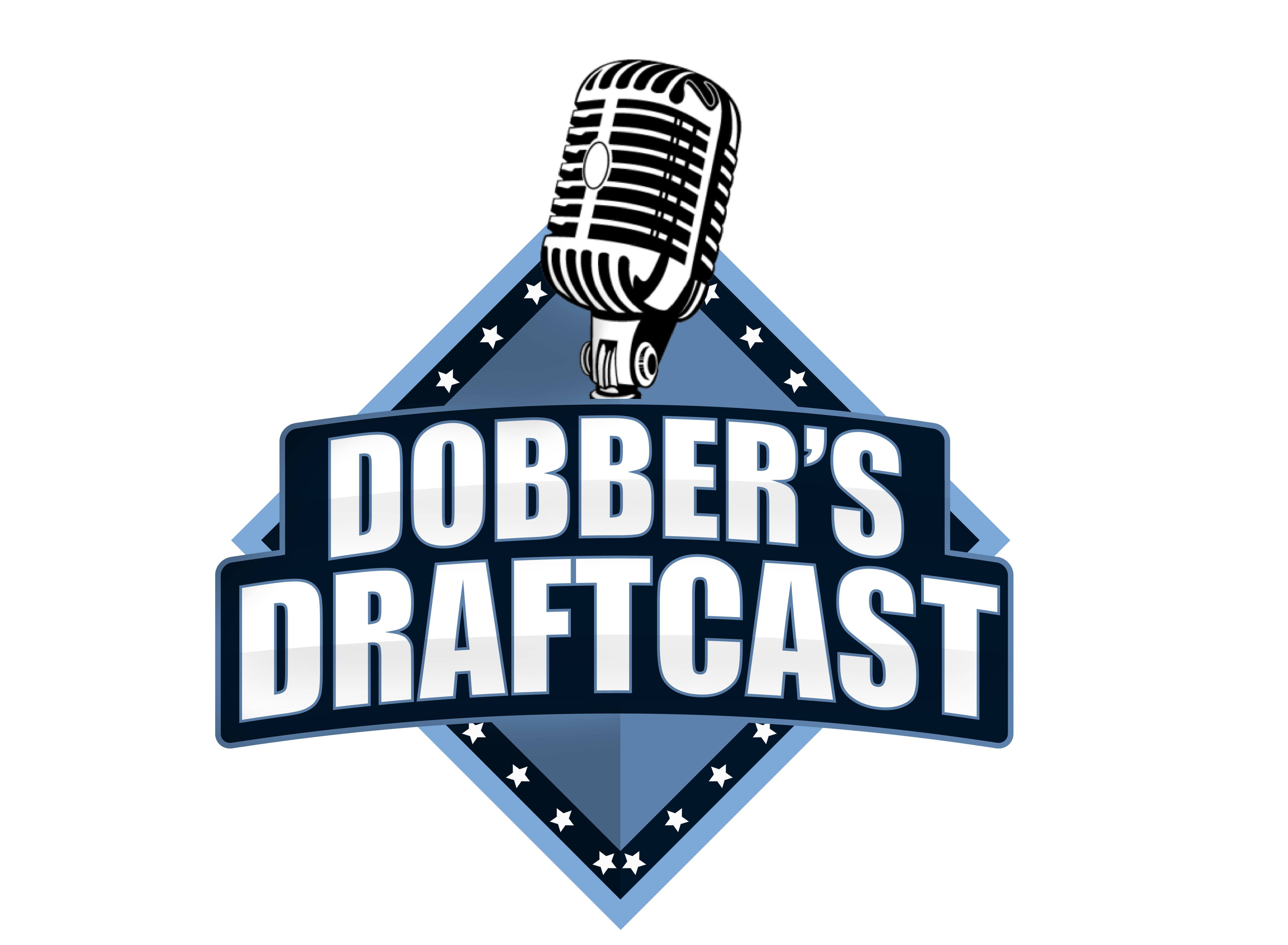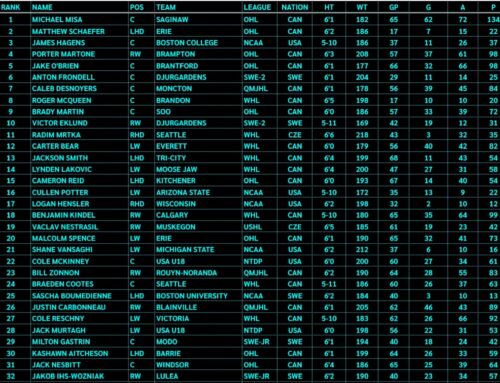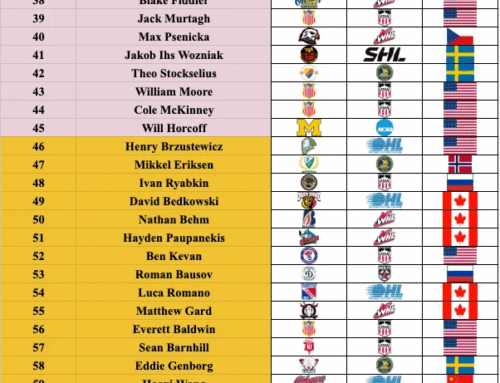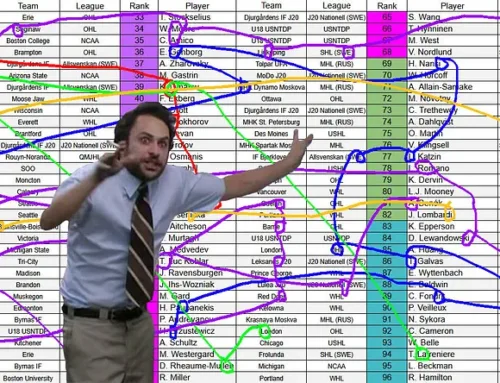Jake O’Brien: A Deep Dive into the Draft’s Premier Playmaker
Luke Sweeney
2025-06-08
By: Luke Sweeney & Kareem Ramadan
Earlier this year, many of our staff were (rightfully) kicking ourselves for a glaring omission from our preliminary rankings: Jake O’Brien.
After an exceptional D-1 where he won the OHL’s rookie of the year, O’Brien fell a bit flat in the opening months in the season, enough for us to feel like he was worthy of exclusion. Clearly, we were wrong. After a half-decent 12 points in his first 15, O’Brien exploded for 86 points in his remaining 51 regular season games, ultimately tying Porter Martone for second in the OHL among draft eligible players. As a result, he’s shot up the rankings and—if recent mocks are any indication—he could be drafted in the top 5.
One of our scouts who has been on the O’Brien train since the beginning is Kareem, who has been tackling both Russia and General Crossover this season. Watching a lot of the OHL this year, Kareem was impressed by his playmaking skill and physicality away from the puck.
As one of the people partially responsible for leaving O’Brien out of our initial ranking, I’ve always been a bit lower on him than the consensus. While throughout his impressive run I’ve come around, O’Brien still has a number of issues that stick out to me that I think are worth discussing.
In order to bridge this gap in opinion, Kareem and I sat down, watched and tracked four of Jake O’Brien’s playoff games, two against North Bay and two against Oshawa. Throughout this article, Kareem and I will present our (mostly) differing impressions to hopefully illustrate O’Brien’s strengths, weaknesses and areas for development.
*******************
Offense
Passing:
Luke: It’s probably best to start in an area where Kareem and I are in agreement: O’Brien can really snap the puck around. Everyone knows what he’s going to do, and they can’t seem to stop him anyway. He can make plays off the wall or off the rush. He sees lanes as they develop and can hit marks with deception.
Based on my tracking, in four games O’Brien created almost 2 xG off passes alone, which—when you consider that the highest value shot that can be taken in my model is worth ~0.46 xG—this is very, very impressive.
Furthermore, per-game, O’Brien was averaging over 8 passes to the low slot with over a 50% success rate. Based on my sample of regular season tracking numbers, this is absurd. Caleb Desnoyers is one of the only players who even approached this level of playmaking volume, but still only averaged ~4 attempts with a ~40% conversion rate.
No one creates high-danger offense off the pass like O’Brien.
Kareem: What sets O’Brien apart isn’t his skill alone, but a mind that processes the game at warp speed. At 17-years-old, O’Brien is already the gold standard for decision-making in the OHL; his ability to process the game borders on precognitive. This stems from both disciplined habits—like his constant scanning for passing options—and innate spatial awareness, allowing him to read space and anticipate openings under pressure, all elevated with a manipulative flair. He weaponizes deception and timing: whether pivoting to shield the puck or improvising with his backhand (like his dazzling spin-o-rama assist to Luca Testa against Oshawa in game 1), O’Brien combines technical skill with high end creativity to bend defenses to his will. His understanding of how to create—not just find—space is what makes him unique.
O’Brien doesn’t have explosive speed, but he compensates along the walls with intelligent stick work and the ability to absorb contact effectively, shield pucks with active stick positioning, and immediately identify passing outlets under pressure. At 6-2, his frame suggests significant physical upside—and the fact he’s already demonstrating such advanced wall play before filling out speaks volumes about his potential.
This skill set is especially valuable for a center projecting to the pro level. Coaches trust pivots who can support defensemen deep in the DZ and turn dead-end retrievals into controlled exits. O’Brien’s wall play doesn’t just help his team escape danger—it shortens defensive shifts and jump-starts transition offense, two hallmarks of effective two-way centers. While flashier plays might dominate highlight reels, it’s these subtle, repeatable habits that often dictate winning hockey.
Offensive Diversity & Power Play Reliance:
Luke: For all his offensive wizardry, there are two unassailable and intimately connected truths about O’Brien’s offence: 1) He is a very one-dimensional playmaker, and 2) He leans a lot on the PP.
What shots O’Brien takes are almost always of high-quality, but the infrequency with which he shoots is a bit startling. Across both my playoff and regular season samples, O’Brien was getting about one shot a game.
That’s just not enough.
As the game gets faster, tighter and more physical at higher levels (levels where more professional organizations can afford extensive pre-scouting) O’Brien will get read like a book. If he wants to become a dangerous NHL playmaker, he’ll need to learn to punish defenders for not respecting his shot.
This is especially true on the PP.
Despite all I’ve said about his “shootiness”, O’Brien still finished with a respectable 32 regular season goals, 22 of them at evens. On the other hand, 47 of O’Brien’s 66 assists came on the special teams. While O’Brien’s playmaking dominance is impressive, it is worth noting that, like many Junior skill players, a lot of his skill-set relies on the space afforded to him by the powerplay.
He loves to put the puck backdoor, to send it cross-ice against-the-grain, and to flit the puck through layers of coverage. However, he often needs time and space, either to draw defender to himself, or for his teammates to exploit. Maybe more importantly than anything, he leans a lot on Nick Lardis, who had 71 goals, the most in the CHL by 9 (and 21 more than any player not named Michael Misa).
In my view, this approach is unsustainable.
A cursory look at the NHL’s top powerplay point getters will help confirm this impression. Big-time PP scorers don’t score over 50% of their points on the man advantage (well except 36-year-old Patrick Kane). Other players who come close to this mark are almost exclusively young snipers on lottery teams (like Dylan Guenther or Connor Bedard). Even among those players, they don’t have similar scoring profiles to O’Brien coming out of Junior—both in terms of goal scoring and PP reliance.
The long-short of it is, I feel that O’Brien’s offensive success at the NHL level will be dependent on whether he can diversify his approach.
Puck Routes:
Kareem: While many hockey viewers focus on puck possession, even dominant players only control the puck for brief moments each shift. The majority of offensive impact happens away from play, an area where Jake O’Brien shows a mature understanding of the game.
Unlike many junior players who wait for the puck to come to them, O’Brien proactively creates offense through intelligent movement. He repeatedly identifies soft spots in coverage, slipping into open ice to become a passing outlet before plays develop. When facing structured defenses, he smartly redirects to the net-front area. The game film reveals numerous examples of O’Brien reading defensive pressure and then drifting into dangerous spaces, ones that either stretch coverage for teammates or position himself for quick strike scoring chances.
This intelligence extends into transition. At his best, O’Brien can study defences from the NZ, drift through layers of coverage, and land in the perfect space and time to receive a pass. In every game we watched, O’Brien had an assist or near-assist by using the space created ahead of him as a trailer on the rush.
****************
Transition
Carrying/Passing/Dumping Profile:
Luke: In DZ exits, I think O’Brien plays his role as the centre well, making retrievals, completing outlet and exit passes, and rarely clearing the puck. Once he passes his own blueline, I begin to have more reservations.
The first is O’Brien’s dumping frequency. Look, I know that this has to do with the way Brantford likes to play, the game tightening in the playoffs, etc. At the same time, O’Brien had more dump-ins than carried and passed entries combined, while also turning the puck over at a pretty high rate considering his transition workload.
More than that, my issue is that O’Brien—the player whose playmaking we have been waxing poetic about for the past 800 words—just doesn’t pass the puck much in transition. He carried the puck in about two times as often as he passed it, and made very few outlet passes in the NZ. This doesn’t look like the transition play of an NHL centre to me.
One of the least translatable Junior hockey skills is carried entries; almost every star prospect can do it themselves at the CHL level, very few NHL players create carried entries all alone. There is a small handful of players in every draft that project as impactful NHL transition carriers. Barring a massive, unprecedented improvement in both his skating and handling (which are both solid), O’Brien will not be one. To find better transition impacts going forward, O’Brien will again need to diversify his approach.
To summarize, O’Brien is not successful at creating controlled entries, even at the OHL level. To improve, he’ll need to lean more into his playmaker DNA, look to build play more patiently and selflessly rather than forcing play up the ice, and to use his passing to create space early in the rush, not just as a finishing play.
***********
Transition Hard-Skills
Kareem: While our tracking data revealed some inconsistencies in O’Brien’s transitional play (particularly in the Oshawa series), there remains significant reason for optimism given his underlying skill set. The numbers illustrate his current tendency toward dump-and-chase hockey in offensive situations—of his 25 tracked neutral/offensive zone transitions, 12 were dump-ins (48%) compared to just 7 carry-ins (28%) and 4 pass-ins (16%). However, his defensive zone exits tell a more promising story: he successfully executed 8 carried exits and 8 outlet passes versus only 3 clears/dumps, demonstrating the hard skills to evolve into an effective transition player.
His passing ability remains a clear strength, particularly in defensive zone breakouts where he excels at quick, short-area plays off the wall. When in open ice, he’s shown the ability to let his playmaking shine, and he can identify and hit streaking linemates with precision.
That said, his skating mechanics present a slight limitation: though agile at top speed, he lacks explosive first-step acceleration which can stall sequences when pressured. The ability to dump the puck in the offensive zone and recover possession—as seen in his 5 successful puck battles post-dump—is a mature skill that becomes increasingly valuable at higher levels of play.
These stats reinforce that O’Brien’s processing speed and passing touch (83% successful exit rate when passing/carrying) already mitigate some transitional concerns. With improved burst to create separation and more reps to refine his entry decisions, he has the toolkit to become a dependable two-way transition center.
**********
Defence
DZ Battles:
Kareem: Jake O’Brien is a competitive, and detail-oriented forward whose game projects best at center at the next level. His habits away from the puck are solid and avoids the temptation to cheat for offense. Instead, O’Brien prioritizes team structure, working hard along the boards to win battles and facilitate clean transitions from defense to offense. His commitment to two-way play makes him a reliable presence in all three zones.
One of the more unusual tendencies in Jake O’Brien’s game is his frequent habit of skating with his stick in the air. While this quirk is less concerning in the offensive zone, it becomes a liability in defensive situations—where even a split-second delay in stick placement can mean the difference between disrupting a play and surrendering a clean passing lane. The issue also surfaces during breakouts, as seen in the clip below against the Battalion. Stationed deep in his own zone to support the defense, O’Brien’s elevated stick—combined with a subtle lean toward the offensive zone—allows the Battalion to intercept the puck on the forecheck. Though it’s a minor technical flaw, and one that should be correctable as he progresses, it’s a critical detail to address. At higher levels, whether in the AHL or NHL, elite opponents will ruthlessly exploit even the slightest lapse in positioning.
Another area requiring development is his face-off ability. Currently, O’Brien struggles on the dot, frequently getting out-muscled and out-leveraged, even on his strong side. While this is not uncommon for a 17-year-old, improving his strength, technique, and anticipation will be crucial for his transition to higher levels of play.
In transition, O’Brien generally tracks back in a straight line through the middle. However, he occasionally defaults to looping routes rather than utilizing sharp starts and stops, limiting his ability to disrupt opponents or support quick counterattacks. These habits may stem from his current skating mechanics, which will need refinement to maximize his efficiency and agility.
Checking Effort:
Luke: O’Brien’s physical, lays big hits, gets involved in the forecheck, and drives the net in a pesky way. However, even in critical moments of elimination playoff games, I wasn’t always impressed with his effort.
There was a play that stood out to me against Oshawa, down 1-3 with less than 9 remaining in the third period of Game 6. A Brantford point shot gets deflected into the left corner of the Oshawa zone. O’Brien:
1) ignores the puck to complain about a missed call, allowing Owen Griffin to easily claim the puck.
2) upon seeing that Griffin has headmanned the puck to Beckett Senecke (putting the two of them along with Callum Ritchie on a 3v2) O’Brien starts quicksand skating and has straight legs in the neutral zone, forcing Patrick Thomas to sprint from Oshawa’s netfront and scramble to pick up a man.
3) Upon seeing Thomas go to pick up Griffin, O’Brien just doesn’t pick up the third man (Sennecke), so that when the puck does come across to Sennecke…
4) Thomas is again forced to cover for O’Brien’s miscue, and gets dangled
5) O’Brien makes a half-hearted play on the puck, and Sennecke, luckily, flubs the puck
6) as soon as the puck is turned back northwards, O’Brien remembers how to skate and sprints on attack.
I also saw several times over the course of the four games where O’Brien made “business decisions” in the DZ corners, letting opponents pick up the puck relatively unimpeded. I’ve seen him be physical, work hard on both sides of the puck, and win battles with either strength or skill. For me, this is a non-negotiable area of improvement, and one he can easily make.
Regardless of where you stand on Jake O’Brien, you can’t deny the appeal: he’s a physical, 6-2 centre, has shown an impressive scoring profile over two seasons in the OHL, and has passing ability and vision that could both be weapons at the NHL level. Nevertheless, there’s no such thing as a perfect prospect and hopefully, through this process, Kareem and I have been able to illuminate the trajectory his development may take.
If you enjoyed this article, make sure to follow Luke (@LukeSweeney17) and Kareem (@HockeyTakes1) on X.com for more prospect updates.






